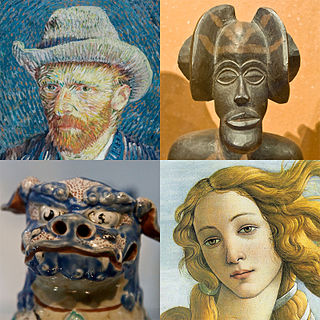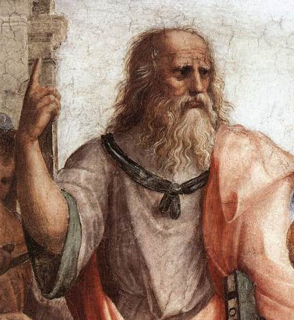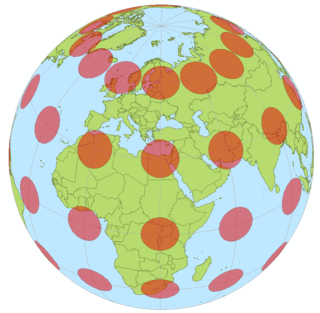
Art is a diverse range of human activities in creating visual, auditory or performing artifacts (artworks), expressing the author's imaginative, conceptual ideas, or technical skill, intended to be appreciated primarily for their beauty or emotional power. Other activities related to the production of works of art include the criticism of art, and the study of the history of art.

Concepts are defined as abstract ideas or general notions that occur in the mind, in speech, or in thought. They are understood to be the fundamental building blocks of thoughts and beliefs. They play an important role in all aspects of cognition. As such, concepts are studied by several disciplines, such as linguistics, psychology, and philosophy, and these disciplines are interested in the logical and psychological structure of concepts, and how they are put together to form thoughts and sentences. The study of concepts has served as an important flagship of an emerging interdisciplinary approach called cognitive science.

In philosophy, idealism is a diverse group of metaphysical views which all assert that "reality" is in some way indistinguishable or inseparable from human perception and/or understanding, that it is in some sense mentally constituted, or that it is otherwise closely connected to ideas. In contemporary scholarship, traditional idealist views are generally divided into two groups. Subjective idealism takes as its starting point that objects only exist to the extent that they are perceived by someone. Objective idealism posits the existence of an objective consciousness which exists before and, in some sense, independently of human consciousness, thereby bringing about the existence of objects independently of human minds.
Process philosophy — also ontology of becoming, processism, or philosophy of organism — identifies metaphysical reality with change. In opposition to the classical model of change as illusory or accidental, process philosophy regards change as the cornerstone of reality—the cornerstone of being thought of as becoming.

Space is the boundless three-dimensional extent in which objects and events have relative position and direction. Physical space is often conceived in three linear dimensions, although modern physicists usually consider it, with time, to be part of a boundless four-dimensional continuum known as spacetime. The concept of space is considered to be of fundamental importance to an understanding of the physical universe. However, disagreement continues between philosophers over whether it is itself an entity, a relationship between entities, or part of a conceptual framework.
In philosophy, rationalism is the epistemological view that "regards reason as the chief source and test of knowledge" or "any view appealing to reason as a source of knowledge or justification". More formally, rationalism is defined as a methodology or a theory "in which the criterion of the truth is not sensory but intellectual and deductive".
Phenomenology is the philosophical study of the structures of experience and consciousness. As a philosophical movement it was founded in the early years of the 20th century by Edmund Husserl and was later expanded upon by a circle of his followers at the universities of Göttingen and Munich in Germany. It then spread to France, the United States, and elsewhere, often in contexts far removed from Husserl's early work.

The Critique of Pure Reason is a book by the German philosopher Immanuel Kant, in which the author seeks to determine the limits and scope of metaphysics. Also referred to as Kant's "First Critique", it was followed by the Critique of Practical Reason (1788) and the Critique of Judgment (1790). In the preface to the first edition, Kant explains that by a "critique of pure reason" he means a critique "of the faculty of reason in general, in respect of all knowledge after which it may strive independently of all experience" and that he aims to reach a decision about "the possibility or impossibility of metaphysics."
An illustrator is an artist who specializes in enhancing writing or elucidating concepts by providing a visual representation that corresponds to the content of the associated text or idea. The illustration may be intended to clarify complicated concepts or objects that are difficult to describe textually, which is the reason illustrations are often found in children's books.

The map–territory relation describes the relationship between an object and a representation of that object, as in the relation between a geographical territory and a map of it. Polish-American scientist and philosopher Alfred Korzybski remarked that "the map is not the territory" and that "the word is not the thing", encapsulating his view that an abstraction derived from something, or a reaction to it, is not the thing itself. Korzybski held that many people do confuse maps with territories, that is, confuse models of reality with reality itself. The relationship has also been expressed in other terms, such as Alan Watts's "The menu is not the meal."
Vested interest is a communication theory that seeks to explain how certain hedonically relevant attitudinal dimensions can influence and consistently predict behavior based on the degree of subjective investment an individual has in a particular attitude object. As defined by William Crano, vested interest refers to the degree to which an attitude object is deemed hedonically relevant by the attitude holder. According to Crano, "an attitude object that has important perceived personal consequences for the individual will be perceived as highly vested. Highly vested attitudes will be functionally related to behavior". Simply put, when people have more at stake with the result of an object that will greatly affect them, they will behave in a way that will directly support or defy the object for the sake of their own self-interest.
Process and Reality is a book by Alfred North Whitehead, in which the author propounds a philosophy of organism, also called process philosophy. The book, published in 1929, is a revision of the Gifford Lectures he gave in 1927–28.
We diverge from Descartes by holding that what he has described as primary attributes of physical bodies, are really the forms of internal relationships between actual occasions. Such a change of thought is the shift from materialism to Organic Realism, as a basic idea of physical science.

The Philosophy of Freedom is the fundamental philosophical work of the philosopher and esotericist Rudolf Steiner (1861–1925). It addresses the questions whether and in what sense human beings can be said to be free. Originally published in 1894 in German as Die Philosophie der Freiheit, with a second edition published in 1918, the work has appeared under a number of English titles, including The Philosophy of Spiritual Activity, The Philosophy of Freedom, and Intuitive Thinking as a Spiritual Path.
In publishing, art, and communication, content is the information and experiences that are directed toward an end-user or audience. Content is "something that is to be expressed through some medium, as speech, writing or any of various arts". Content can be delivered via many different media including the Internet, cinema, television, radio, smartphones, audio CDs, books, e-books, magazines, and live events, such as speeches, conferences, and stage performances.
Presence is a theoretical concept describing the extent to which media represent the world. Presence is further described by Matthew Lombard and Theresa Ditton as “an illusion that a mediated experience is not mediated." Today, it often considers the effect that people experience when they interact with a computer-mediated or computer-generated environment. The conceptualization of presence borrows from multiple fields including communication, computer science, psychology, science, engineering, philosophy, and the arts. The concept of presence accounts for a variety of computer applications and Web-based entertainment today that are developed on the fundamentals of the phenomenon, in order to give people the sense of, as Sheridan called it, “being there."
Mediation in Marxist theory refers to the reconciliation of two opposing forces within a given society by a mediating object. Similar to this, within media studies the central mediating factor of a given culture is the medium of communication itself. The popular conception of mediation refers to the reconciliation of two opposing parties by a third, and this is similar to its meaning in both Marxist theory and media studies. For Karl Marx and Friedrich Engels, this mediating factor is capital or alternately labor, depending on how one views capitalist society.
Joshua Meyrowitz is a professor of communication at the department of Communication at the University of New Hampshire in Durham. He has published works regarding the effects of mass media, including No Sense of Place: The Impact of Electronic Media on Social Behavior, an analysis of the effects various media technologies have caused, particularly television.
Dr. Louis Ormont was an American psychologist and one of the earliest practitioners of group psychotherapy based on a psychoanalytic model.
Social Presence Theory was developed by social psychologists John Short, Ederyn Williams, and Bruce Christie, co-authors of the 1976 book The Social Psychology of Telecommunications, where they defined Social Presence Theory as the ability communication media have to transmit social cues. The theory arose from noticing the differences in apparent physical proximity inherent in using various communications media.
A theory of art is intended to contrast with a definition of art. Traditionally, definitions are composed of necessary and sufficient conditions and a single counterexample overthrows such a definition. Theorizing about art, on the other hand, is analogous to a theory of a natural phenomenon like gravity. In fact, the intent behind a theory of art is to treat art as a natural phenomenon that should be investigated like any other. The question of whether one can speak of a theory of art without employing a concept of art is also discussed below.






